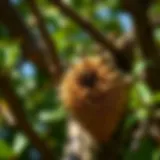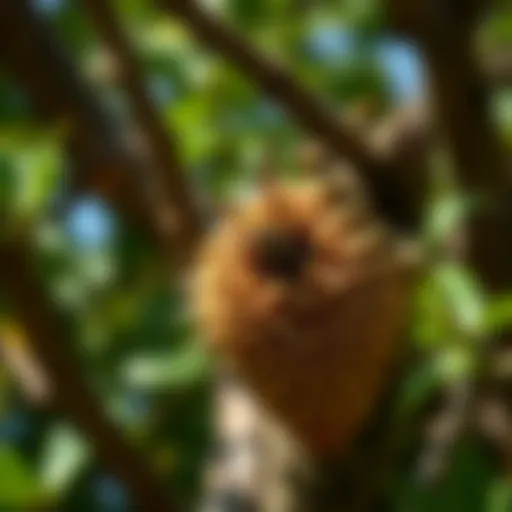Understanding Tomcat Vole Bait: Efficacy and Safety
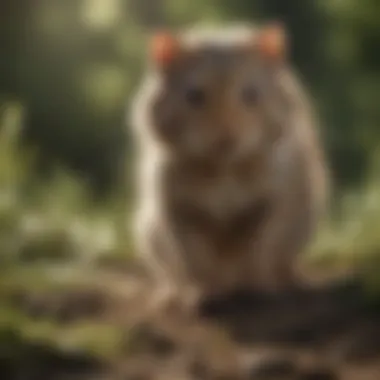

Intro
In many regions, voles can present a significant challenge for homeowners and land managers. These small rodents often damage gardens, lawns, and crops, leading to frustrations for those who wish to maintain their outdoor spaces. Understanding how to effectively manage vole populations is critical. One method that has garnered attention in this context is Tomcat Vole Bait. This article delves into the effectiveness, application methods, and important considerations surrounding this bait, providing a resourceful overview for both homeowners and professionals.
Pest Identification
Correctly identifying pests is the first step in managing them effectively.
Detailed Descriptions of Common Pests
Voles, particularly the Meadow Vole (Microtus pennsylvanicus) and the Prairie Vole (Microtus ochrogaster), are the most common types encountered. These rodents are typically small and stocky, about 5 to 8 inches long, with short tails. They have a fur that ranges from brown to gray, which helps them blend into their environments.
Signs and Symptoms of Infestations
Several indications can point to a vole infestation:
- Tunneling: Surface tunnels in grass or garden areas indicate vole activity.
- Bites on plants: Voles often gnaw the stems of plants, leading to visible damage.
- Droppings: Small, dark droppings may be seen near feeding sites.
Recognizing these signs early can help in taking action before the problem escalates.
Prevention Strategies
While rodent control is essential, preventing infestations in the first place is preferable.
Home Maintenance Tips for Pest Prevention
- Trim Vegetation: Keep grass and shrubs well-trimmed to reduce hiding places.
- Sealing Entrances: Inspect and seal entry points in structures to limit access.
Natural Deterrents and Barriers
Utilizing natural methods can be beneficial. Some effective deterrents include:
- Essential oils: Some voles dislike the smell of peppermint or cedarwood.
- Physical barriers: Using wire mesh around garden beds can prevent access.
Treatment Options
When prevention fails, treatment may be necessary. Understanding the options available can help in making a wise choice.
Overview of Chemical vs. Natural Treatments
Tomcat Vole Bait is a well-known chemical option, but there are also natural alternatives available. Chemical solutions often act quickly, while natural methods tend to be slower but may pose less risk to non-target species and the environment.
Step-by-Step Guides for DIY Treatments
For those who prefer a hands-on approach:
- Identify the active areas: Look for signs of voles.
- Choose your method: Decide between Tomcat’s bait or a natural deterrent.
- Apply accordingly: Follow instructions carefully for chemicals to ensure safety.
- Monitor the situation: Keep an eye on the treated areas to assess effectiveness.
Always consider the impact of any treatment on the surrounding environment.
Throughout this exploration, it remains essential to approach the control of vole populations with a comprehensive understanding. Being informed enables homeowners and professionals to choose the right methods that align with their values and safety requirements.
Prolusion to Tomcat Vole Bait
Understanding the dynamics of pest management, specifically with regard to Tomcat Vole Bait, is increasingly crucial for homeowners and those managing landscaping. Voles can cause significant damage to gardens and lawns due to their burrowing and feeding habits. Incorporating an effective solution like Tomcat Vole Bait not only safeguards plants but also maintains the aesthetic appeal of outdoor spaces. This section provides essential insights into what Tomcat Vole Bait is and how it has evolved over time, offering context that highlights its relevance in pest control.
Definition and Purpose
Tomcat Vole Bait is a specialized rodenticide designed targeting vole populations. Voles are small, burrowing rodents that, when present in large numbers, can wreak havoc on crops, gardens, and ornamental plants. The purpose of Tomcat Vole Bait is straightforward: to reduce these populations effectively and quickly. This product is particularly vital for gardeners who have invested time and resources in maintaining their landscapes. The bait is formulated to be palatable to voles while being potent enough to ensure a rapid and humane death.
Historical Development
The development of Tomcat Vole Bait can be traced back to broader advancements in rodent control. Over the years, methods of managing rodent populations have shifted from traditional traps to the use of more refined chemical solutions. Tomcat products, gaining popularity since their introduction in the late 20th century, have benefitted from scientific research and technological innovations. This evolution allows them to provide a targeted approach with a focus on minimizing harm to non-target species, making them a preferred choice for integrated pest management strategies today.
Understanding the historical context of this bait enhances its credibility among those aiming to control voles responsibly and effectively.


Understanding Vole Behavior
Understanding the behavior of voles is paramount when discussing Tomcat vole bait. This segment delves into the intricacies of vole species and their ecological impacts. By comprehending these aspects, homeowners can effectively strategize pest control measures tailored to their specific situations. Knowing the species is essential because different species exhibit unique behaviors, habitats, and food preferences. Furthermore, recognizing the ecological role of voles sheds light on their interactions within the ecosystem and the potential repercussions of controlling their populations.
Species Identification
Voles belong to the family Cricetidae, which includes various species, such as the meadow vole (Microtus pennsylvanicus) and the pine vole (Microtus pinetorum). Identifying the specific species of vole present on a property can significantly influence the choice and application of bait.
- Meadow Voles: These voles tend to prefer open habitats where grass is abundant. Their burrowing behavior is characterized by surface tunnels, making them more visible.
- Pine Voles: Unlike their meadow counterparts, pine voles prefer wooded areas and burrow extensively underground. Their presence may go unnoticed until significant damage occurs.
Differentiating these species can help direct the use of Tomcat vole bait to the right areas. Homeowners can also tailor their control strategies based on food sources and nesting preferences, ensuring a more effective outcome.
Ecological Impact of Voles
The ecological impact of voles cannot be understated. They serve as a food source for various predators, including hawks, owls, and foxes. When examining the impact of controlling vole populations, one must balance pest control with the health of the ecosystem.
- Vegetation Consumption: Voles primarily feed on grasses, roots, and tubers. Infestations can lead to significant damage in gardens and agricultural areas, reducing biodiversity.
- Soil Aeration: Despite their reputation as pests, voles can contribute positively to the environment. Their burrowing habits help aerate the soil, facilitating water infiltration and promoting healthy plant growth.
Understanding these interactions allows for more informed decisions regarding pest control. It is crucial to remember that while controlling vole populations is necessary, it must be approached with care to protect the overall ecosystem's integrity.
"The balance between managing pests and preserving ecological systems is delicate and requires careful consideration of various factors."
Composition of Tomcat Vole Bait
Understanding the composition of Tomcat Vole Bait is crucial for those engaged in pest management. The formulation, which combines various active and inert ingredients, determines the bait's effectiveness against voles. Proper knowledge of these components assists homeowners and professionals in applying it correctly, enhancing its efficacy while minimizing environmental risks.
Active Ingredients
Tomcat Vole Bait primarily includes the active ingredient bromethalin. This substance is a potent neurotoxin that affects the central nervous system of rodents. Its mechanism of action disrupts the energy production in cells, leading to paralysis and death. The advantage of bromethalin is its efficacy at lower doses compared to traditional anticoagulants, which often require multiple feedings to be lethal.
Other formulations may contain different active components, such as chlorophacinone. This ingredient belongs to the anticoagulant class. It works over time, requiring multiple feedings to achieve a lethal dose. Despite its effectiveness, the slower action can lead to unintended consequences, such as secondary poisoning of non-target wildlife.
It is essential to read labels carefully to understand which active ingredients are present. Each has unique properties that affect how it works and its safety profile for non-target species.
Formulation Variants
Tomcat offers various formulation variants tailored for specific applications. These include pellets, granules, and blocks, each designed to meet different user preferences and environmental conditions.
- Pellets: These are compact and easy to distribute. They are often favored in open field applications, where voles are more likely to encounter them.
- Granules: These are typically larger and can be scattered over a broader area. Granules may be more suitable for gardens or grassy areas where voles are known to burrow.
- Blocks: These are designed to withstand moisture, making them ideal for damp environments. Blocks can be a good choice if you experience high humidity or rainfall.
Choosing the right formulation depends on the specific situation, including the location of the infestation and environmental factors. By understanding the options available, users can maximize the bait's effectiveness, ensuring that it addresses the vole problem efficiently.
"Proper understanding of the active ingredients and formulations is key in selecting the right bait for effective vole control."
In summary, a comprehensive understanding of the composition of Tomcat Vole Bait aids in making informed decisions regarding its use. Knowing whether to select a product with bromethalin or an alternative, along with the appropriate formulation type, will lead to better pest management outcomes.
Application Techniques
The application techniques for Tomcat vole bait are vital for ensuring maximum effectiveness in controlling vole populations. Proper application not only enhances the bait's efficacy but also minimizes potential risks to non-target species and the environment. Understanding the nuances of application methods can lead to more successful pest management strategies for homeowners and professionals alike.
Field Application Guidelines
When applying Tomcat vole bait in outdoor settings, several guidelines should be observed to optimize its performance.
- Timing: Apply bait during seasons when voles are most active. This often coincides with late summer and early fall. Understanding the life cycles of the voles can help in planning the timing.
- Placement: Position bait stations in areas with known vole activity, such as near burrows, fresh tunnels, or feeding sites. This increases the chances of a vole encountering the bait.
- Bait Stations: Utilize sturdy, weather-resistant bait stations to protect the bait from the elements. This also helps to deter non-target animals. Ensure that these stations are secure but still allow voles easy access.
- Quantity: Follow manufacturer instructions regarding the amount of bait to use. Over-application can lead to waste, while under-application may not effectively control the vole population.
- Monitoring: Regularly check bait stations to assess consumption rates. Replace uneaten bait promptly to maintain freshness. Additionally, observe for signs of vole activity or decrease in populations.
Following these field application guidelines ensures that Tomcat vole bait works effectively and safely.
Indoor Usage Considerations
Applying Tomcat vole bait indoors requires a different approach compared to outdoor use. Here are important considerations:
- Identify Entry Points: Before applying indoor bait, inspect for any entry points that voles may be using to access your home. Sealing these gaps should be part of an integrative pest management plan.
- Disguise the Bait: Place bait discreetly in areas that voles are likely to roam, such as basements, attics, or crawl spaces. Avoid placing bait in common living areas to minimize exposure to children and pets.
- Safety Precautions: Use enclosed bait stations specifically designed for indoor use. This prevents accidental consumption by non-target species and reduces the risk of contamination.
- Personal Monitoring: After applying bait indoors, monitor these areas over time. Changes in rodent activity can indicate the effectiveness of the bait used. Keeping records of bait usage and observations can inform future pest management strategies.
"Effective application techniques are essential for maximizing the control of vole populations and ensuring safety for non-target species."
In summary, understanding both field application guidelines and indoor usage considerations can significantly enhance the effectiveness of Tomcat vole bait. By following these principles, homeowners can engage more proactively in managing vole populations while considering safety and environmental impacts.
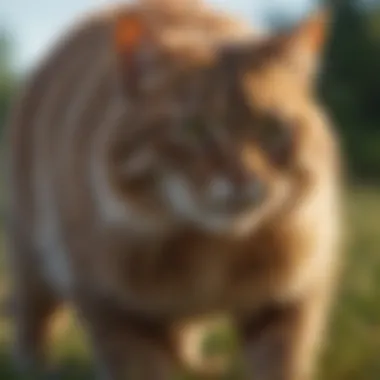

Effectiveness of Tomcat Vole Bait
The efficacy of Tomcat vole bait is a critical aspect of effective pest control. Homeowners and professionals alike must evaluate how well the bait accomplishes its primary function: reducing vole populations in various environments. This evaluation involves examining specific elements such as success rates, application methods, and comparison with other pest management options.
Success Rates in Various Settings
Success rates of Tomcat vole bait depend on a range of factors including location, timing, and application strategy. Research indicates that, when applied correctly, Tomcat vole bait significantly diminishes vole numbers in both rural and suburban settings.
- Field Studies: In agricultural fields, Tomcat bait has shown an effectiveness rate of over 85%. Factors contributing to this success include optimal placement of bait stations and timing in relation to vole activity patterns.
- Residential Areas: When used in gardens and lawns, results vary but many homeowners report visible decreases in vole populations within weeks. It is crucial to monitor the areas where bait is applied for signs of activity or bait consumption.
- Urban Environments: The success in urban settings is somewhat lower. This can be due to increased disturbances, such as wildlife and pets disturbing the bait stations.
Comparative Analysis with Other Baits
When comparing Tomcat vole bait to other products in the market, several aspects should be examined: composition, ease of use, and environmental impact.
- Active Ingredients: Tomcat uses specific anticoagulants that are effective against voles, compared to other brands that may utilize different chemicals which could be less effective or pose higher risks to non-target species.
- Ease of Application: Many users find Tomcat bait noticeably easier to apply, with clear instructions and effective bait station designs. In contrast, other baits might require complex preparation or professional installation.
- Environmental Considerations: Tomcat takes safety into account by lessening risks to beneficial wildlife, while other baits may carry higher risks of accidental poisoning. This is essential when integrating baits into environments with pets or children present.
Overall, Tomcat vole bait demonstrates strong effectiveness in controlling voles when implemented thoughtfully. Users should consider each application to maximize results while minimizing potential risks.
"Effective pest control is not only about achieving desired outcomes but also ensuring safety for all species involved."
Homeowners and pest control professionals must remain informed on variations in efficacy across different environments, as well as the comparative advantages of using Tomcat bait over its competitors. This knowledge is crucial for making informed decisions in pest management strategies.
Environmental Considerations
Environmental considerations are crucial when using Tomcat vole bait. Their impact does not only extend to the targeted vole population but also affects other aspects of the ecosystem. It is essential to understand these implications to ensure that pest management strategies are effective while safeguarding the surrounding fauna and flora.
Using Tomcat vole bait responsibly means acknowledging its potential effects on non-target species. This includes beneficial organisms such as predatory birds and mammals that regulate rodent populations, as well as native plant life that might be exposed to the bait. It is vital to minimize any risks to these species to maintain ecological balance.
Furthermore, familiarity with regulatory guidelines can aid users in making informed decisions. Adhering to local regulations ensures that the application of Tomcat vole bait is compliant with environmental protection standards. Being aware of these guidelines promotes responsible use which can significantly mitigate negative ecological consequences.
Impact on Non-target Species
The use of Tomcat vole bait raises concerns about its potential impact on non-target species. This includes wildlife that could ingest bait accidentally or through the food chain. For instance, if a bird of prey consumes a vole that has ingested the bait, there is potential for toxicity to transfer. This transfer can lead to decreases in local predator populations, thereby disrupting the ecosystem further.
It is important to recognize that certain bait formulations may be more harmful than others. To mitigate these risks:
- Application location should be strategically chosen to avoid areas frequented by non-target animals.
- Timing of application can also play a role. Applying bait when non-target species are less active can help reduce exposure.
- Educating homeowners about these risks can further promote responsible usage.
Regulatory Guidelines
Regulatory guidelines are designed to ensure that the use of Tomcat vole bait aligns with environmental safety standards. Each region may have specific rules regarding the usage of rodenticides. These regulations can dictate where and when baits can be applied and may include directives around specific methods of disposal.
Adhering to these guidelines is not just a legal responsibility but an ethical one as well. Homeowners are encouraged to:
- Check local regulations before purchasing or applying Tomcat vole bait.
- Read product labels carefully for specific instructions.
- Report any incidences of non-target species being affected, which helps in the collection of data regarding product effectiveness and safety.
By following these guidelines, users can contribute to a safer environment for both non-target species and their own property. Regulatory compliance minimizes ecological risks and fosters a healthy balance in the wilderness around homes and within gardens.
Safety Precautions
Understanding safety precautions when using Tomcat vole bait is essential for effective pest management. This section underscores careful handling and proper storage methods. Moreover, it touches on necessary first aid measures for any accidental exposure. Knowing these factors will ensure not only personal safety but also the safety of surrounding environments.
Handling and Storage Instructions
When dealing with Tomcat vole bait, proper handling is critical. Adhere to the following guidelines:
- Use gloves during application to protect your skin from potential irritation or allergic reactions.
- Avoid ingestion. Keep the bait away from food and drink to minimize contamination risks.
- Store in a cool, dry place. This helps maintain the efficacy of the bait and prevents degradation.
- Seal tightly after use. Ensure the container is closed to prevent accidental access by children or pets.
- Dispose responsibly. Follow local regulations for disposal to prevent any negative environmental impact.
Inappropriate handling or storage can lead to reduced bait effectiveness and unwanted side effects. Therefore, taking these steps seriously is vital.
First Aid Measures
In the event of accidental exposure to Tomcat vole bait, having a clear understanding of first aid measures is crucial. Follow these steps:
- Inhalation: If ingested through breathing, move to fresh air immediately. Seek medical help if necessary.
- Skin Contact: Remove contaminated clothing and wash the skin with soap and water thoroughly. If irritation persists, consult a medical professional.
- Eye Exposure: Rinse eyes immediately with clean water for at least 15 minutes. Seek help if discomfort continues.
- Ingestion: If the bait is swallowed, do not induce vomiting. Contact a poison control center or seek medical attention without delay.
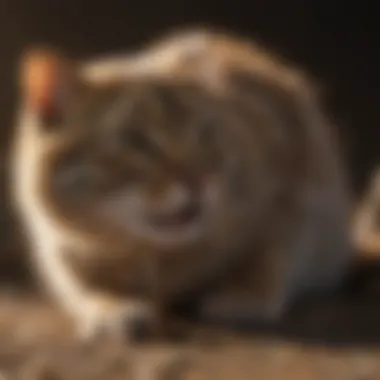

Important: Always keep the product container or label handy when seeking medical advice. This allows professionals to understand the substance involved which aids in effective treatment.
Following these precautions will minimize risks and promote safe application of Tomcat vole bait. Awareness and preparedness can mitigate potential accidents and their consequences.
Integrating Tomcat Vole Bait into Pest Management Plans
Integrating Tomcat Vole Bait into pest management plans is crucial for an effective approach to controlling vole populations. It moves beyond mere application to formulating a strategy that considers the broader implications of pest control. This section focuses on how to seamlessly incorporate this bait into existing pest management plans for both residential and professional environments.
Using Tomcat Vole Bait involves understanding its specific role within a comprehensive management strategy. The bait serves not just as a reactive measure but as a proactive component. It can improve the overall efficacy of pest control efforts when used in conjunction with habitat manipulation, regular monitoring, and public awareness about voles.
A well-integrated pest management plan can lead to better outcomes in reducing vole populations while minimizing potential side effects on non-target species and the surrounding environment.
Best Practices for Use
When using Tomcat Vole Bait, adhering to best practices enhances effectiveness and safety. Here are key guidelines to consider:
- Assess Vole Activity: Before applying the bait, monitor areas for signs of vole activity. Look for runways, burrows, and feeding signs.
- Strategic Placement: Position bait in areas where voles are most active. This could be near burrows, along pathways, or in gardens. Ensure that the bait is placed where pets and non-target species cannot access it.
- Follow Label Instructions: Always refer to the manufacturer’s instructions for application rates and safety precautions. Misuse of the bait can reduce its effectiveness.
- Rotate Bait Types: To prevent bait shyness, consider rotating Tomcat with other types of vole control methods. This keeps the voles from becoming accustomed to a single bait type.
“Effective management not only removes the immediate threat but also restores harmony in the ecosystem.”
- Combine with Trapping: Where feasible, use trapping in conjunction with baiting. This dual approach can enhance control efforts and help gather data about the vole population.
Monitoring and Assessment Strategies
Monitoring and assessment are vital components of integrating Tomcat Vole Bait into pest management plans. Through monitoring, homeowners and professionals can evaluate the success of the baiting strategy and make necessary adjustments.
- Track Bait Consumption: Regularly check bait stations to assess how much bait has been consumed. This can indicate the level of vole activity and permit timely responses.
- Environmental Impact Observation: Observe any impact on surrounding flora and fauna. If there are noticeable effects on non-target species, reassess bait placement and application frequency.
- Outcome Evaluation: Set specific objectives for pest control. After using Tomcat Vole Bait, review whether those objectives were met concerning vole reduction. Adjust tactics based on the results.
- Documentation: Keep records of application dates, locations, and quantities used. This information can help analyze trends over time.
By employing these strategies, individuals can create a more effective pest management plan that not only addresses current vole problems but also anticipates future invasions.
Common Misconceptions about Vole Baits
Understanding common misconceptions regarding vole baits is vital for effective pest management. Many people harbor misunderstandings about how these products work, their safety, and their effectiveness. Addressing these common myths can lead to more informed decisions, potentially resulting in better pest control outcomes. By clarifying certain aspects of vole baits, homeowners and professionals can navigate the complexities of pest management more efficiently, ensuring both effectiveness and safety in their approaches.
Dispelling Myths
One prevalent myth is that all bait products are harmful to the environment. While it is true that certain baits can pose risks, Tomcat Vole Bait is formulated to minimize such impacts. The ingredients are crafted to target voles specifically, reducing unintended consequences for non-target species. Many believe that using a higher quantity of bait guarantees better results. This is not the case, as following the recommended application guidelines ensures both effectiveness and safety.
A common misconception is that vole baits can be left out indefinitely without consequence. In reality, it is crucial to remove any uneaten bait after a designated period. This helps prevent potential access to non-target animals and reduces the risk of poisoning or other environmental hazards.
Finally, the idea that all pest control solutions, including vole baits, work in isolation is misleading. Integrated pest management strategies will yield the best results when various methods, including habitat modification and regular monitoring, are utilized alongside bait applications.
Clarifying Efficacy and Safety
Concerns regarding the efficacy and safety of Tomcat Vole Bait stem largely from misconceptions. Many assume that its effectiveness is not proven. However, research supports that when used correctly, Tomcat Vole Bait provides significant success in controlling vole populations in various settings. This results in population reductions, which ultimately protect gardens, crops, and landscapes from damage.
Furthermore, some believe that safety features of bait means that it is completely non-toxic. Although Tomcat Vole Bait is designed with safety in mind, it remains essential to adhere to handling protocols. These include safe storage practices to avoid accidents and injuries.
It is also important to acknowledge that safety extends beyond human health. The impact of bait on broader ecosystems must be considered. Keeping non-target wildlife in mind during application decreases the likelihood of adverse effects, ensuring that the benefits of using vole baits do not overshadow environmental considerations.
The proper application and understanding of Tomcat Vole Bait can lead to successful management of vole populations while maintaining ecosystem health.
In summary, dispelling myths about vole baits encourages responsible use. Understanding efficacy and safety enhances the ability of consumers to safeguard their properties effectively.
Epilogue and Recommendations
The topic of Conclusion and Recommendations holds significant weight in the discussion surrounding Tomcat Vole Bait. It acts as a critical bridge between the gathered insights throughout the article and their practical applications in real-world scenarios. Understanding how to appropriately utilize this bait, while being aware of the surrounding environmental implications, is vital for both homeowners and pest management professionals. This section synthesizes key takeaways that underscore best practices and future needs in pest control.
Summary of Key Insights
Throughout the exploration of Tomcat Vole Bait, several key insights emerged:
- Efficacy in Control: This bait has demonstrated effectiveness not only in reducing vole populations but also in preventing potential damage to gardens and landscaping.
- Application Techniques: Proper application techniques are essential. This includes understanding field guidelines for outdoor use and considerations for indoor application to ensure safety and optimal results.
- Safety and Environmental Impact: The formulations of Tomcat Vole Bait are designed with environmental safety in mind. It's crucial to follow handling instructions to mitigate risks to non-target species.
- Integrated Pest Management: Tomcat Vole Bait should be incorporated into a broader pest management strategy that includes monitoring and assessment. This practical approach enhances efficacy while promoting ecological responsibility.
In summary, a comprehensive understanding of Tomcat Vole Bait’s formulation, application, and ecological impact equips users with the knowledge to make informed pest management decisions.
Future Directions in Pest Control Research
The potential for future research in pest control, particularly concerning Tomcat Vole Bait, remains expansive. Here are several avenues worth exploring:
- Formulation Improvements: Ongoing research may yield enhanced formulations that increase efficacy while minimizing environmental risks, particularly to non-target species.
- Long-Term Effects: Studies assessing the long-term effects of bait applications on ecosystems can provide deeper insights into sustainability and safety.
- Public Awareness Campaigns: Increasing awareness about proper usage instructions and safety measures is essential. Research could focus on the effectiveness of educational initiatives aimed at homeowners and pest control professionals.
- Comparative Studies: Further research comparing Tomcat Vole Bait with other pest control methods may yield valuable data to refine best practices in pest management.
- Innovative Application Techniques: Exploring new technologies or methodologies for application can enhance efficiency and effectiveness in various settings.
Ongoing diligence in research will facilitate better pest management strategies, ensuring that pests are controlled without compromising the stability of surrounding ecosystems. The focus should remain not only on efficacy but also on fostering environmental stewardship within our communities.
